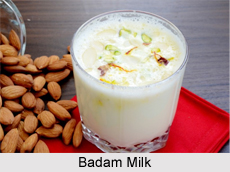 Badam Milk, also known as "Almond Milk" is a delicious Indian drink made by blending almonds with milk and is gently flavoured with cardamom and Saffron or Rose. This drink is not only a delight to taste but is also packed with nutrients. Cold Badam Milk is a great summer cooler and if prepared using warm milk, it is a great winter drink too. The consistency of almond milk is similar to dairy milk but it has a refreshing taste and flavor unlike cow"s milk. Again there are added health benefits of having almond milk everyday. In the refrigerator the almond milk stays best for 3 to 4 days.
Badam Milk, also known as "Almond Milk" is a delicious Indian drink made by blending almonds with milk and is gently flavoured with cardamom and Saffron or Rose. This drink is not only a delight to taste but is also packed with nutrients. Cold Badam Milk is a great summer cooler and if prepared using warm milk, it is a great winter drink too. The consistency of almond milk is similar to dairy milk but it has a refreshing taste and flavor unlike cow"s milk. Again there are added health benefits of having almond milk everyday. In the refrigerator the almond milk stays best for 3 to 4 days.
Health Benefits of Badam Milk
Almonds are very good for health and brain development. The traditional and ancient Badam Milk recipe is made after soaking them and boiling the milk. The healthiest way of making almond milk is to soak them for 6 to 8 hours and then prepare it and it has numerous health benefits. Soaked almonds are easily digestible and nutrients are better absorbed by the body. The Badam Milk recipe is an age old traditional ayurvedic secret to build up immunity in kids, improve eye sight, build stronger bones, remove constipation and provide adequate nutrition.
Ingredients for Badam Milk:
•Almonds - 1 cup
•Pistachios - 1 cup
•Milk - 3 cups, chilled or warm
•Sugar to taste
•Cardamom Powder - 2/3 tsp
•Kewra Essence - 2 tbsp (optional)
•Rose Water - 2 tsp
Method:
1. Grind the almonds and pistachios to a smooth paste in your food processor.
2. Add a little milk to do this.
3. Now add rest of the milk, sugar, cardamom powder, kewra essence and rose water. Blend it well.
4. Serve chilled or warm in a tall glass.
5. Garnish with chopped almonds and edible rose petals or chopped pistachio and saffron strands.
Notes for Badam Milk:
Sometimes this mix can get a little thicker, at that time just mix some more milk and sugar to taste while serving. One could add chopped Badam to this to get a little bite of Badam in between. The Badam Milk can also be flavoured with Kesar by adding few strands of saffron to it.
Related Articles
Indian Beverages
Indian Food
Traditional Indian Beverages
Beverages in Vedic Period
Beverages in Mauryan Empire
Beverages of Kashmir
Wild Almond Tree in India
Badam
Almond Kheer




















